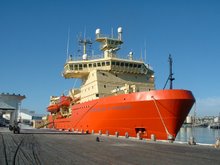cores. And they should! Cores provide the best record of climate
changes over the past half million or so years. Not to mention it's
pretty cool to drill 4 km into a block of ice.
What I'm doing on this cruise is basically the same thing, only we're
using water in a different form. Ice traps air as it is compressed
from above by accumulating snow. Seawater exchanges gas with the
atmosphere only when it is on the surface of the ocean. Over time,
ice is squeezed into thinner and thinner layers, and removing a
vertical column of ice can reveal concentrations of gases (and
isotopes of gases) which provide a record of almost anything climate
related (temperature, precipitation, both local and globally
averaged), and a snapshot of the composition of the atmosphere when
the ice was buried (technically after all of the pores close off).
In the ocean, it's a little more complicated -- once water sinks,
it's very hard to keep it in the same place (but remember ice moves
around too), and it mixes with water around it (but not much!). But
ocean tracers (as all of these gases are known) can provide almost
the same information than ice cores -- and are especially important
over the timescales associated with water sinking to depth and rising
to the surface -- hundreds to thousands of years. Dissolved gases
provide not only information about their source regions, and when and
where the water sank, but also can help us learn how much the water
which we sample has mixed along the way to it's eventual sampling
container aboard the NBP.
The preceding diversion (which I hope you made it through without
closing the page) is really a lead in to the main activity today --
sea ice coring! My partner in water-catching (as our leader
describes our activity) is interested in the transport of the gases
we're analyzing through sea-ice (or just needed an elaborate ruse to
get off the ship after a month). So we are trying to use a similar
sampling method to what were using for some of the dissolved gases to
look at the concentrations in ice -- which reminds me I really need
to describe the sampling (which involves power tools and immersion in
-2 degree water) soon, but not today. Along with a group who was
deploying an automated weather station, we were lowered to an ice
floe on an innertube with a rope ladder attached to it (like a
teepee). Then we took our own core of snow and ice -- about 30-40 cm
of snow and about 2m of sea ice. The weather timing was poor,
horizontal snow and no visual differentiation of snow and sky, about
-10 degrees, but it was worth it to get out on the ice again. Whether
the technique will work is unknown, but it was a nice break in the
schedule, which, a month into the cruise, is not exactly full of
surprises.
And thanks to Kate, a visitor whose email has inspired me to get back
into the science a little.
C


1 comment:
Yay! Very cool stuff -- thanks!
Kate
Post a Comment